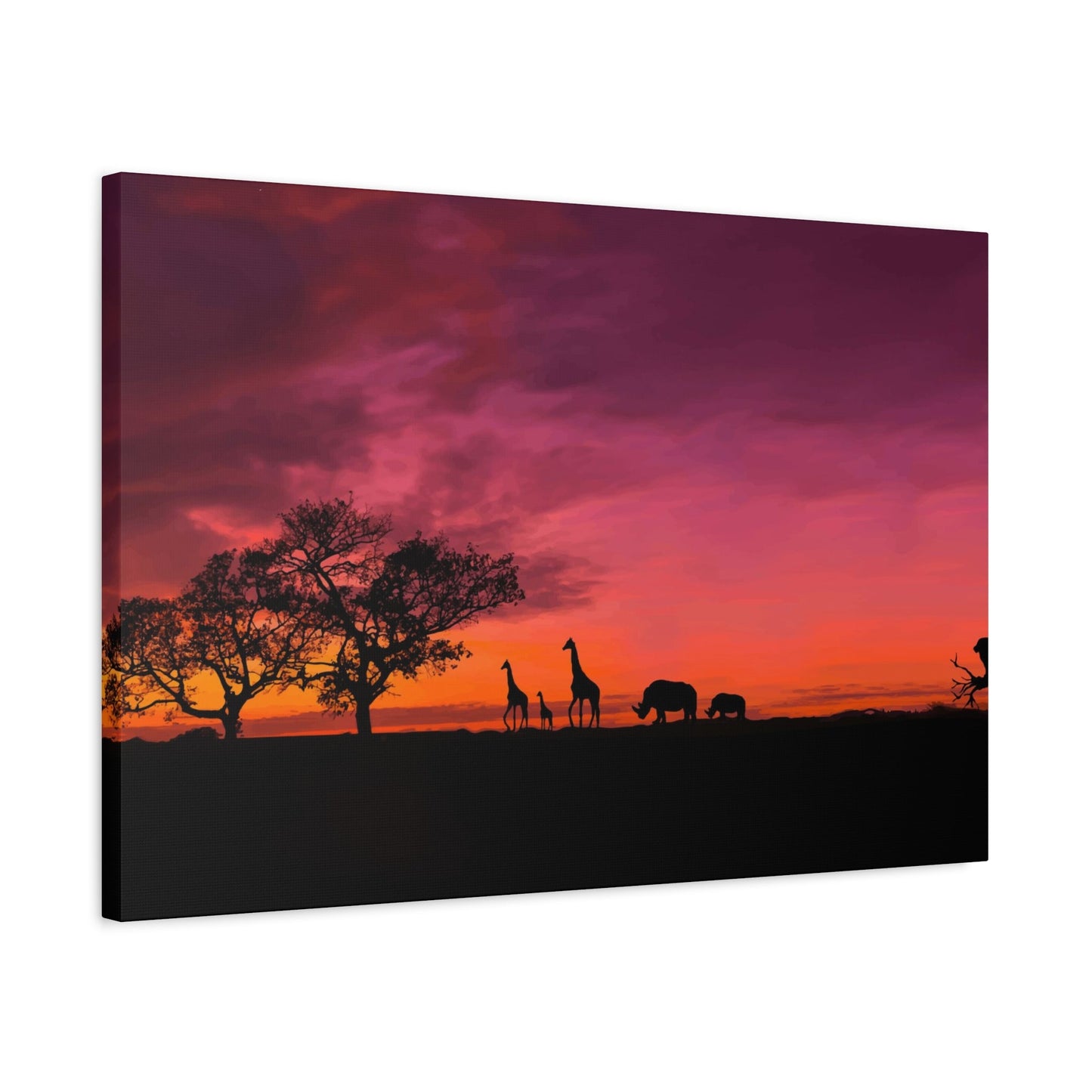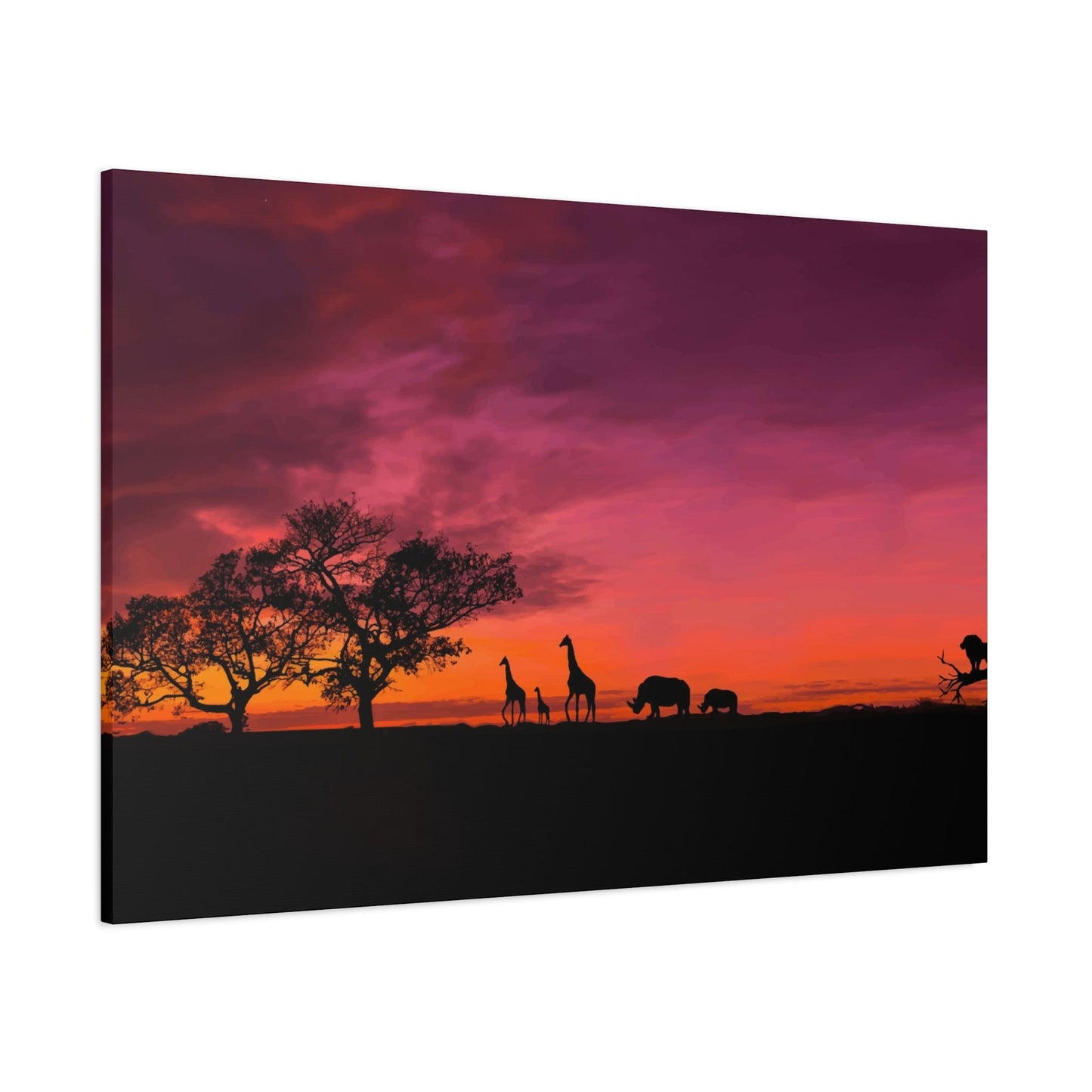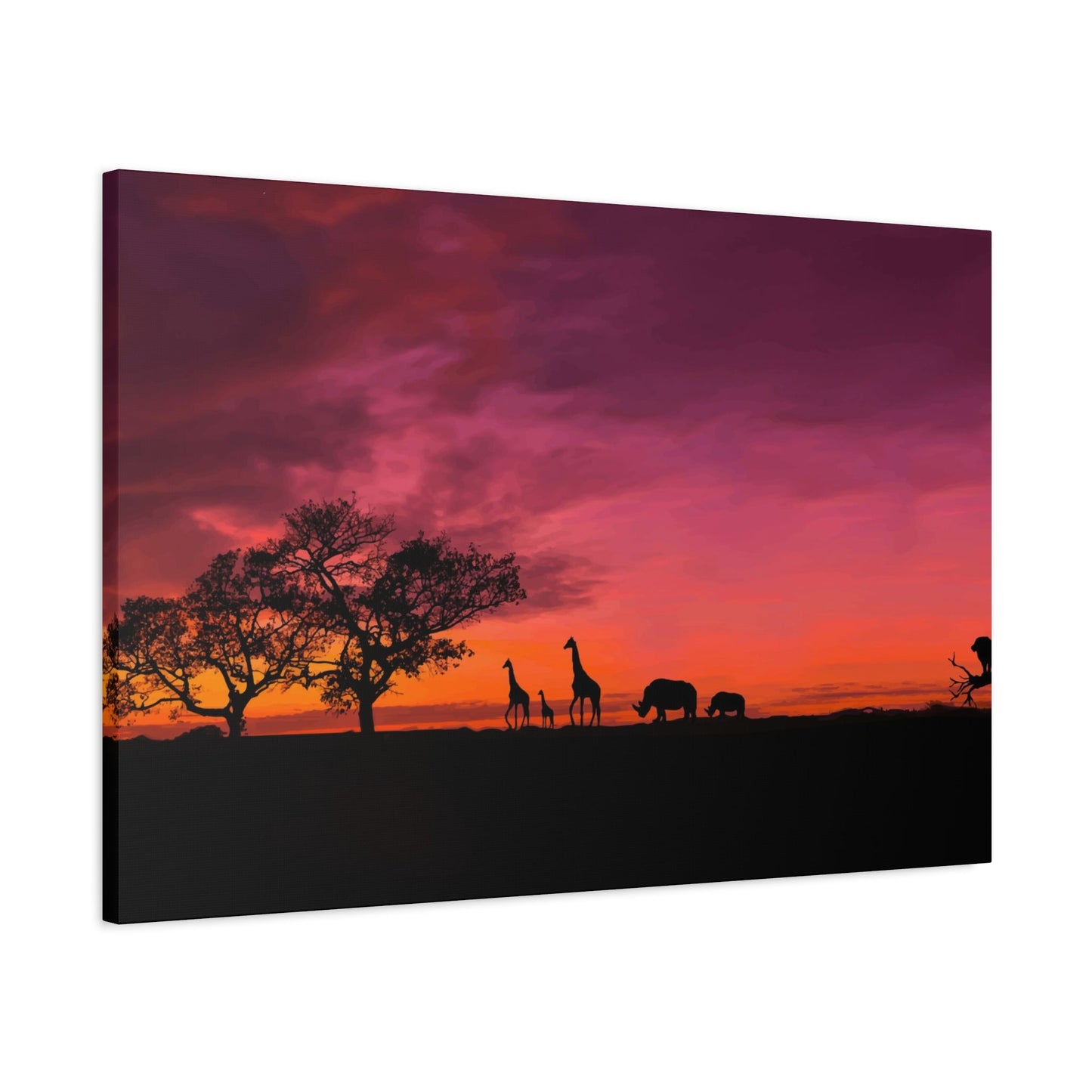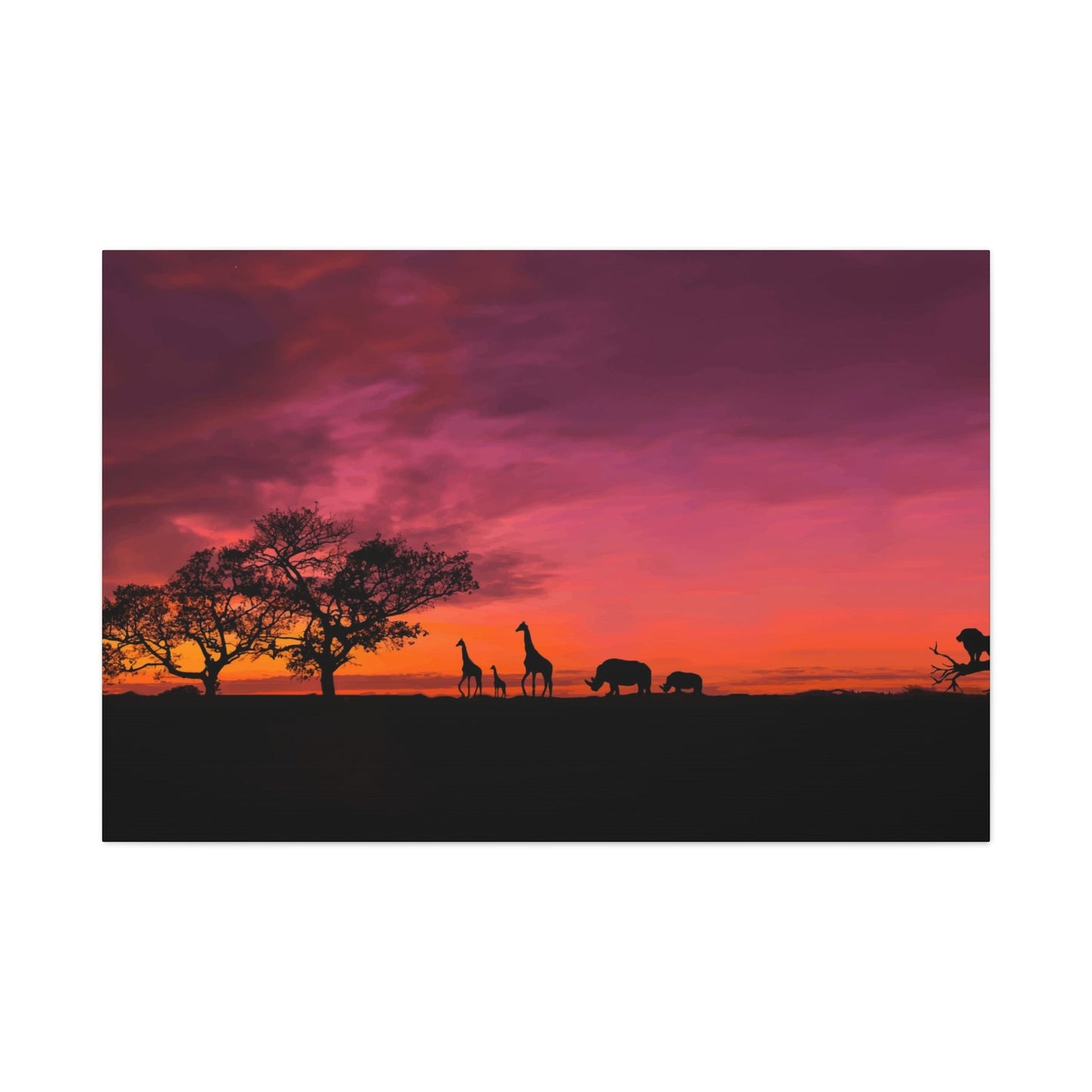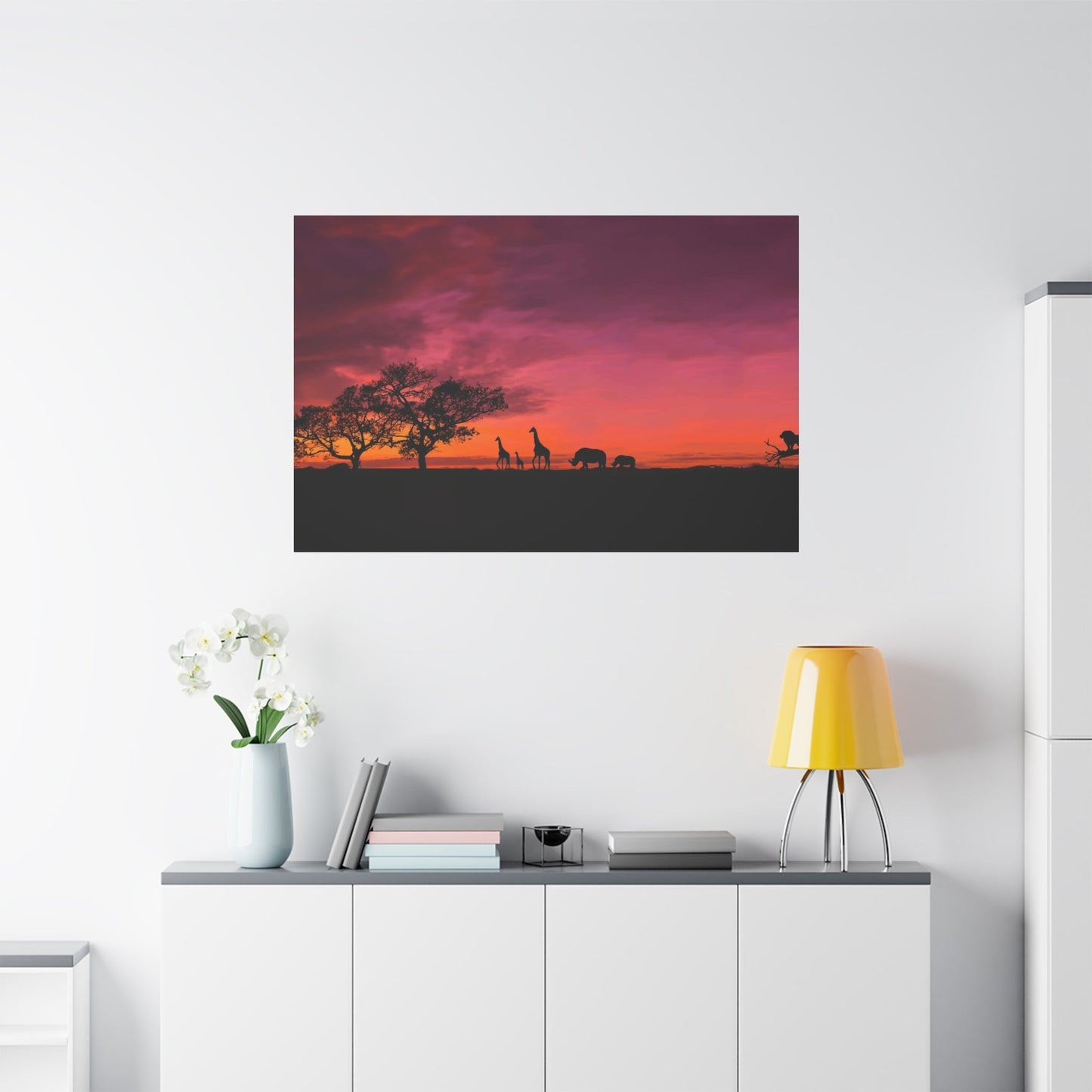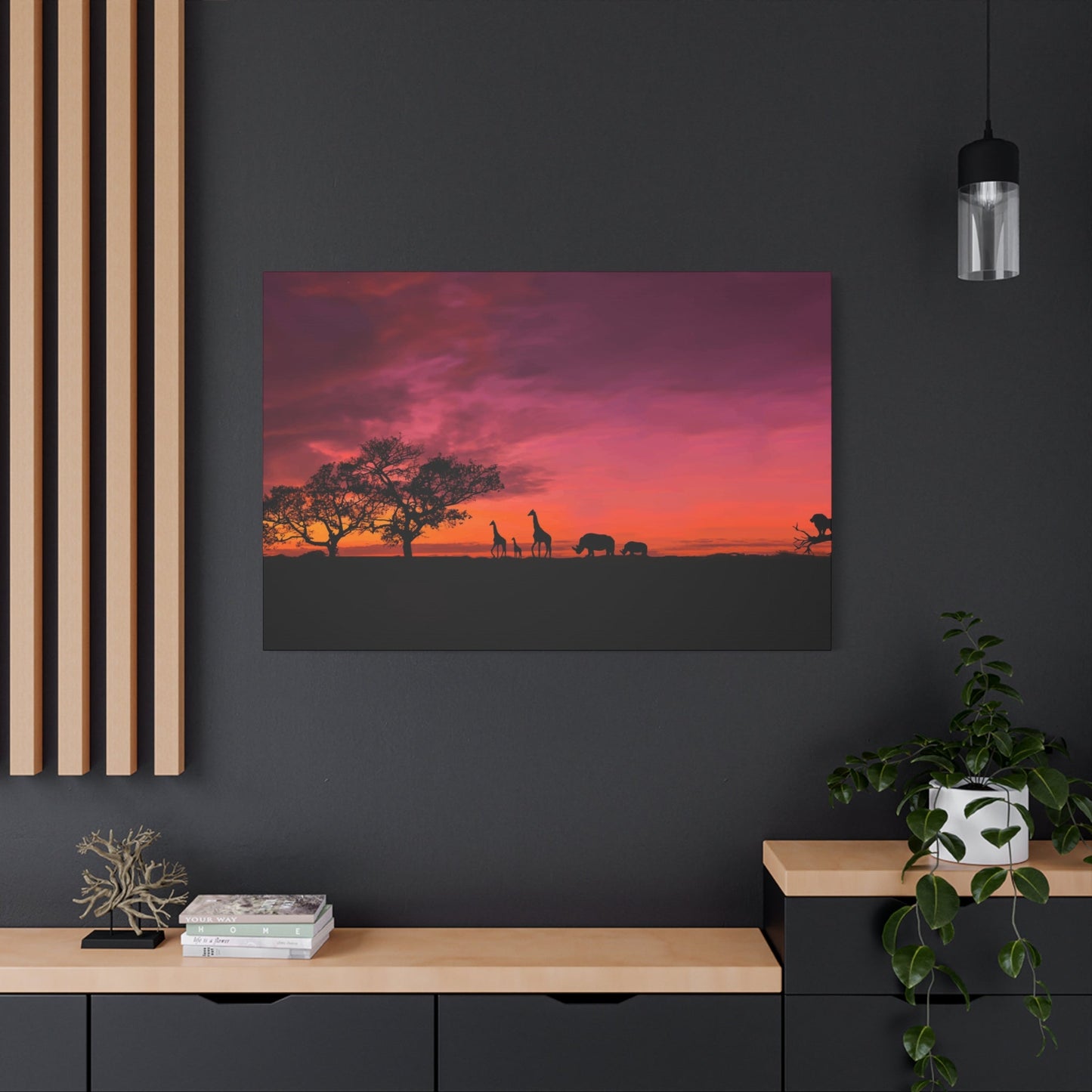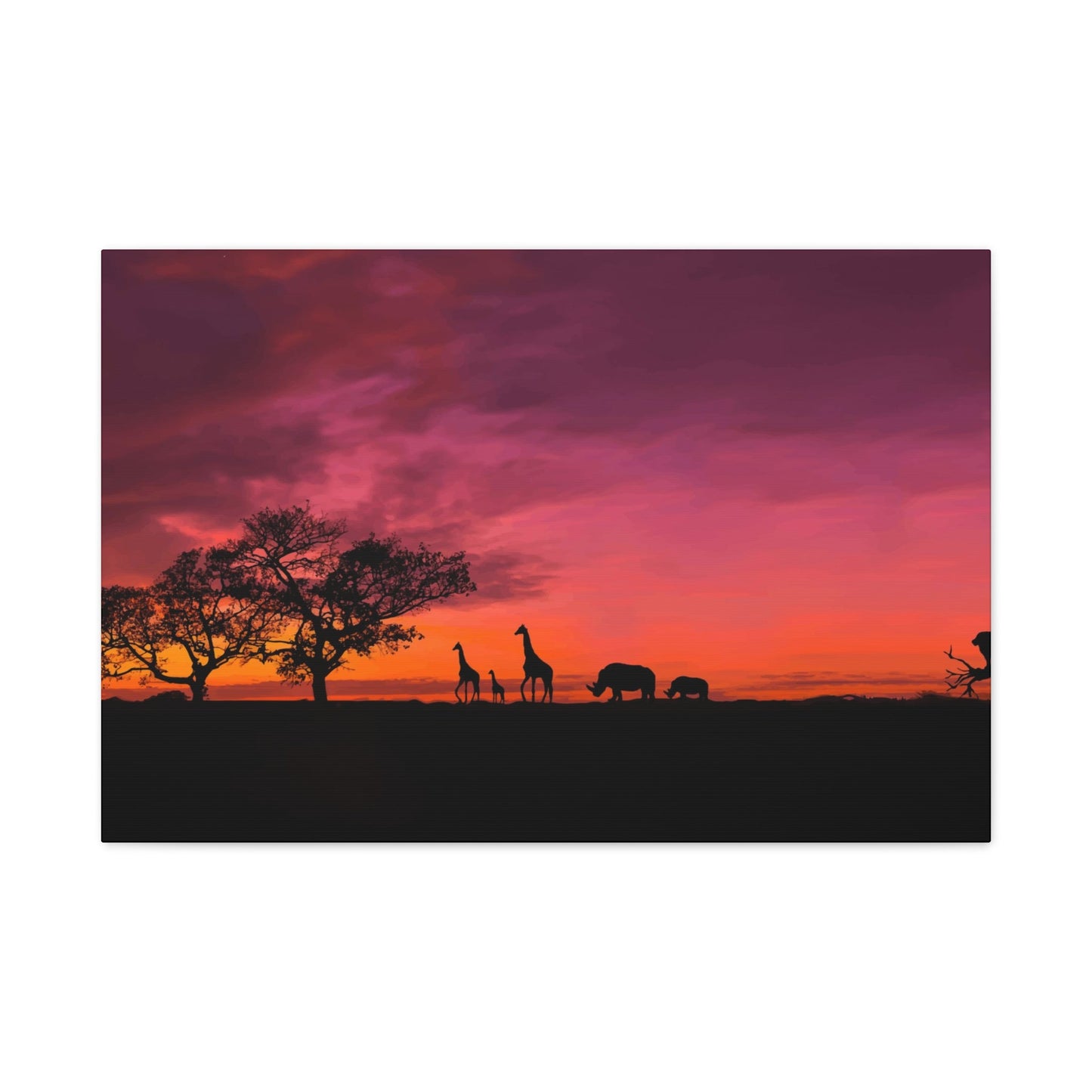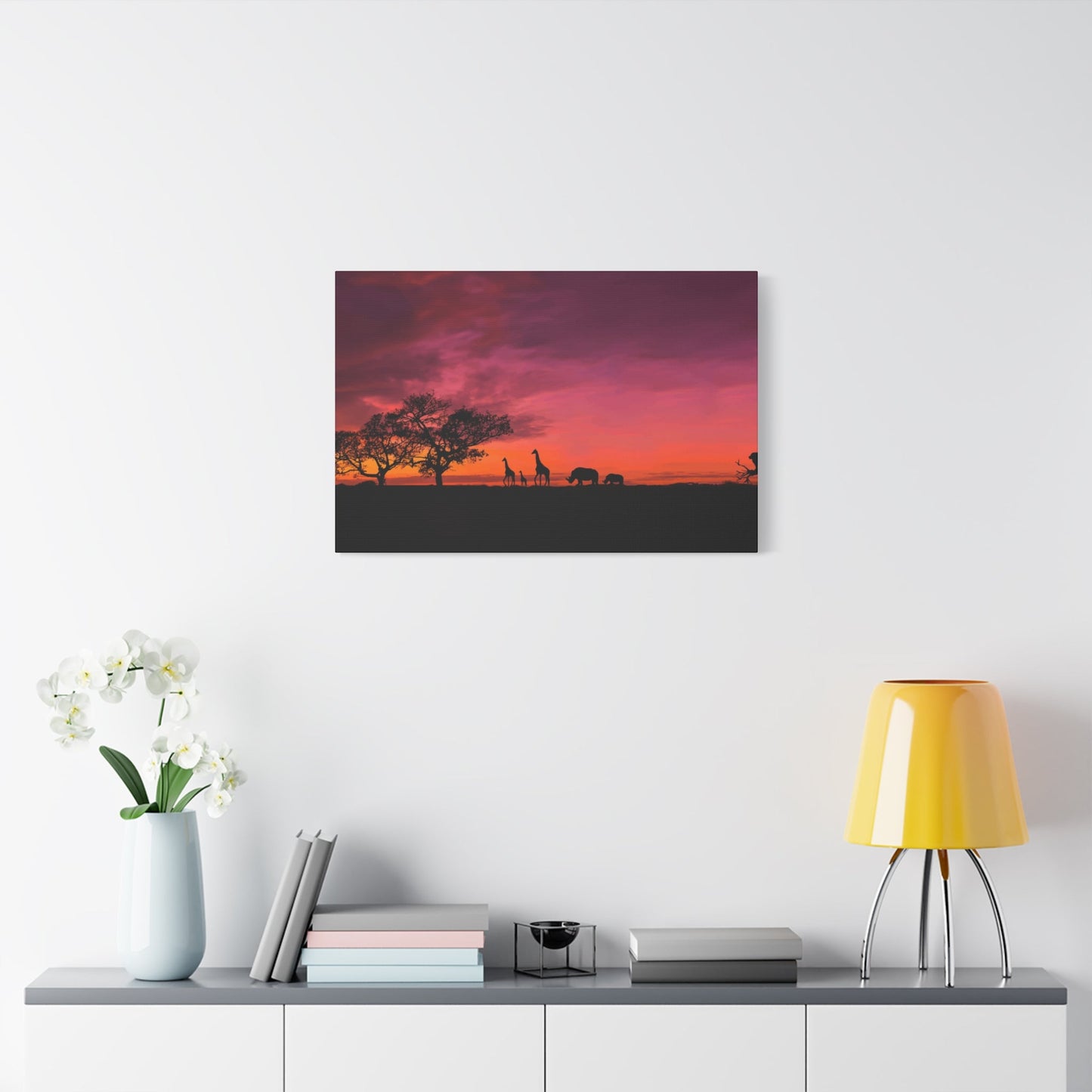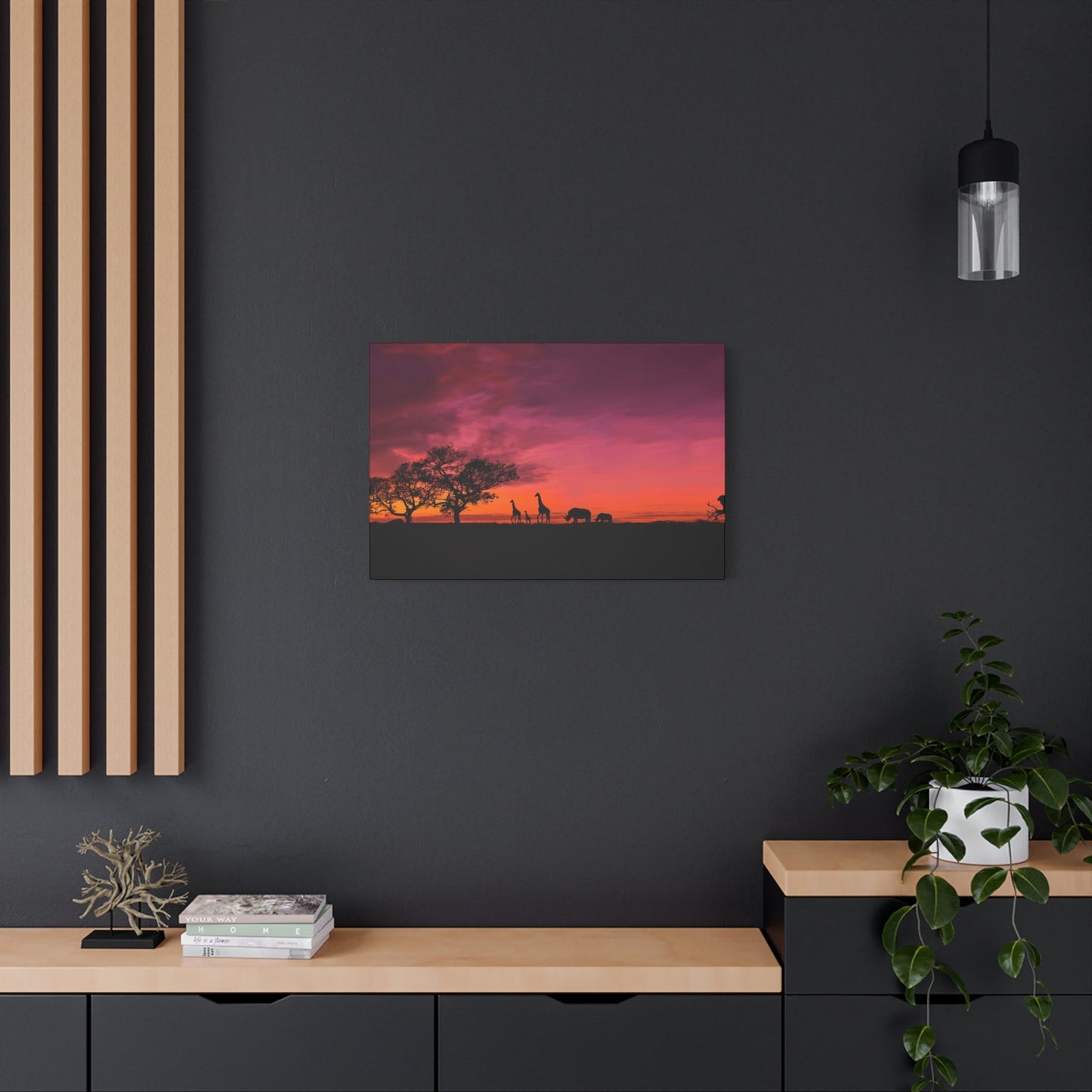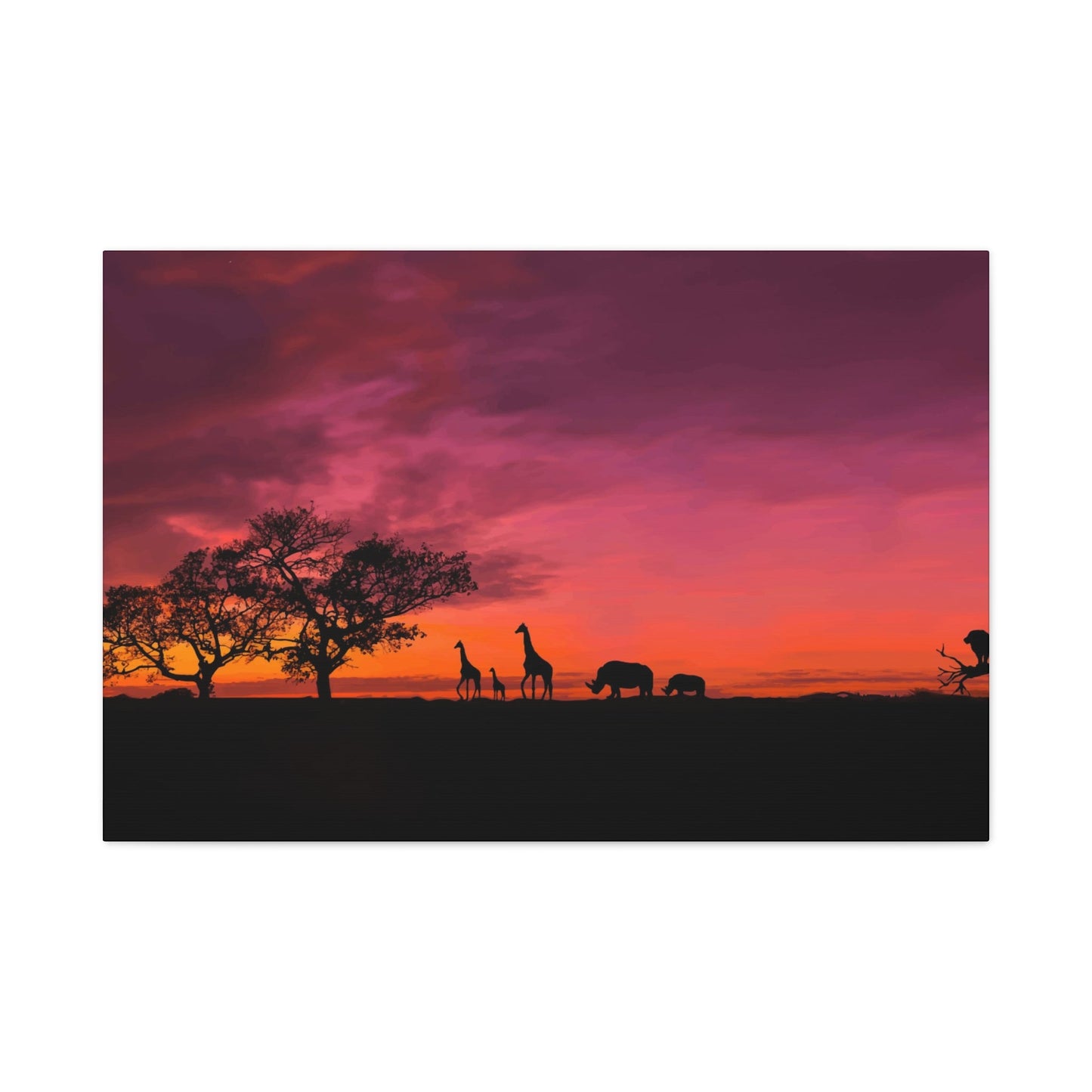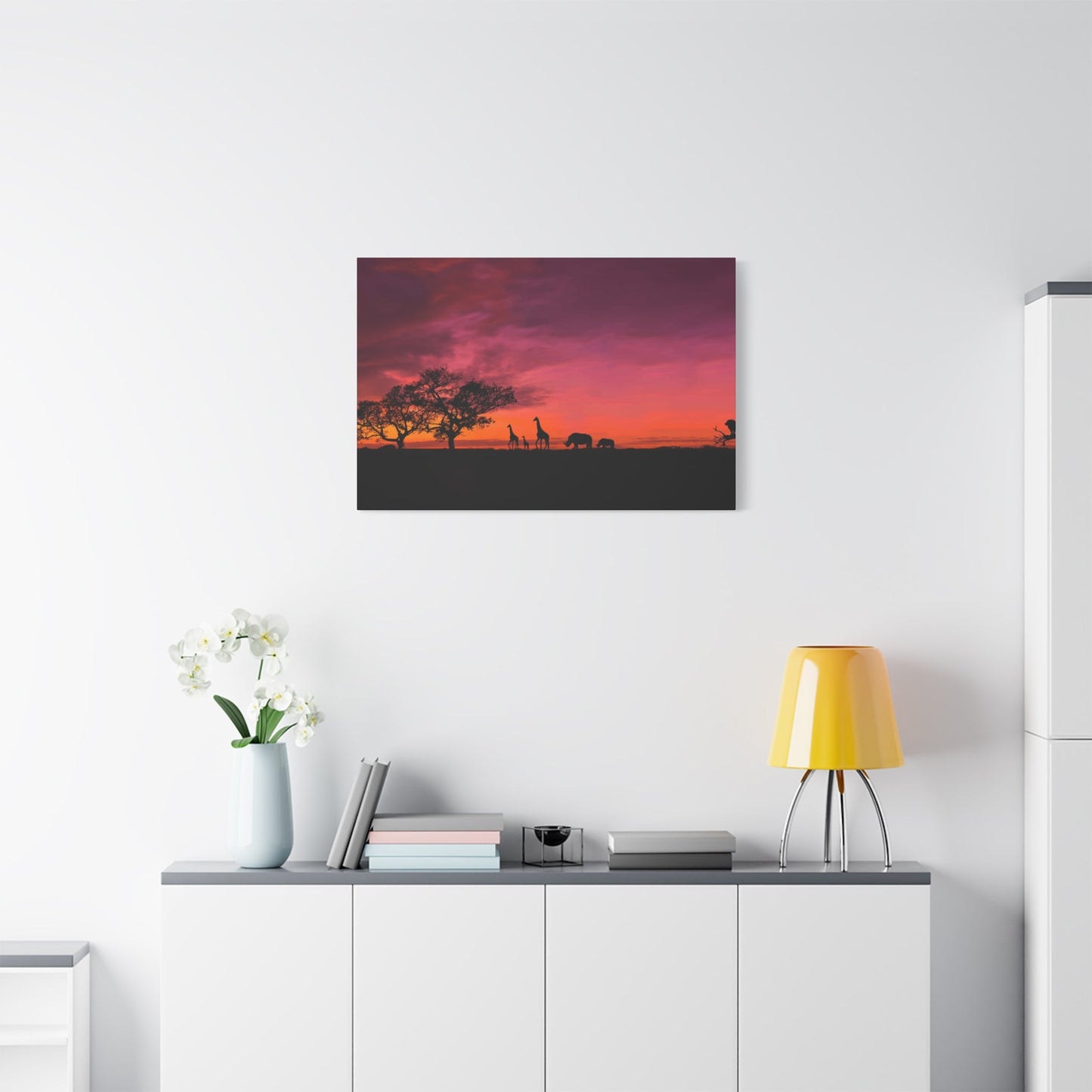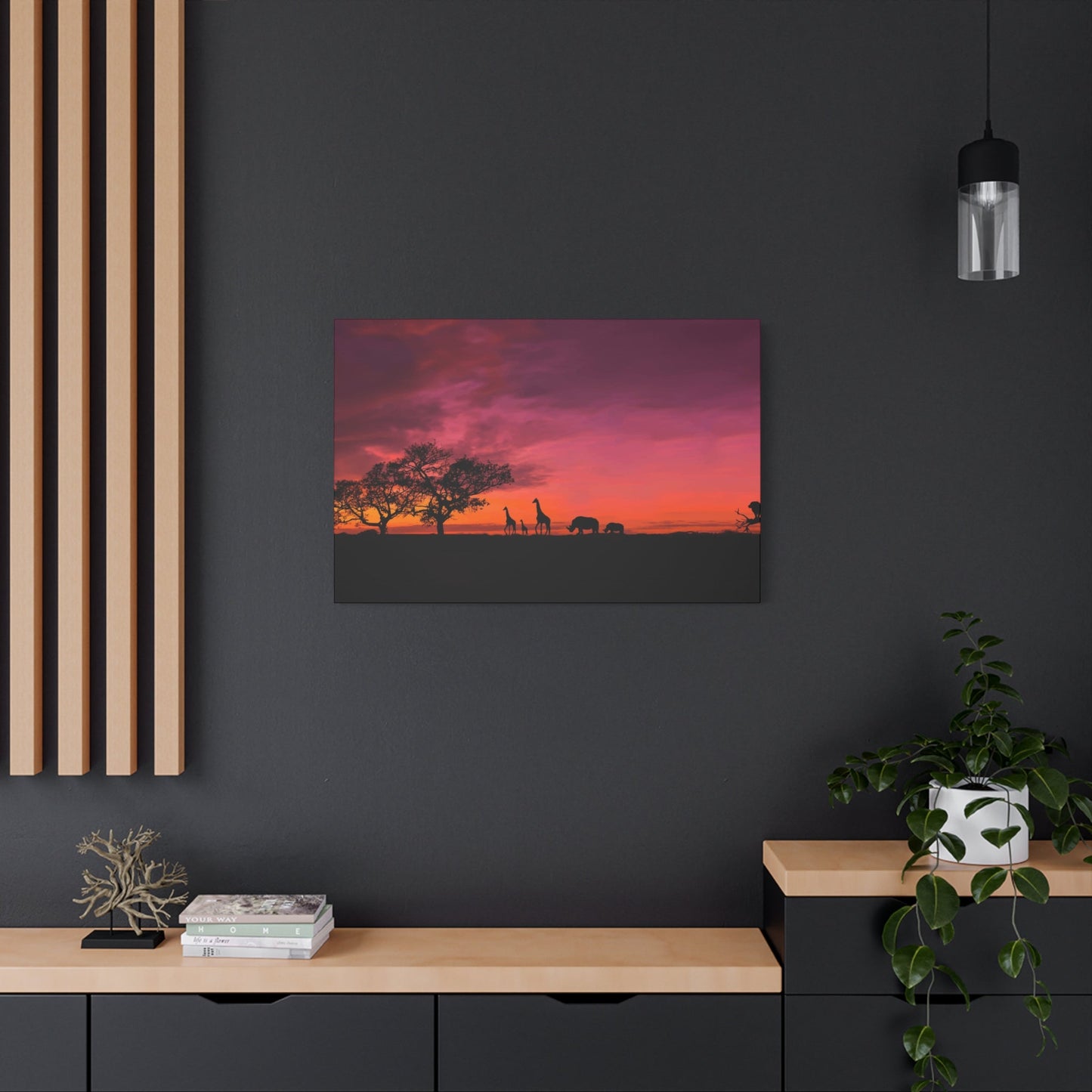The Ultimate Guide to Dusk Wildlife Wall Art: Embrace Nature’s Twilight Hours
The transitional period between daylight and darkness holds a unique fascination for nature enthusiasts and art collectors alike. When creatures of the wild are captured during these fleeting moments, the resulting imagery carries an emotional weight that few other artistic subjects can match. This comprehensive exploration examines how these twilight-themed pieces can transform living environments while celebrating the natural world's most mystical hour.
Capturing the Magic of Dusk in Wildlife Art
The golden hour before nightfall presents photographers and painters with extraordinary opportunities to document animal behavior against breathtaking backdrops. During these precious minutes, the sun's trajectory creates dramatic lighting conditions that emphasize textures, shapes, and movements in ways that midday brightness cannot replicate. Artists who specialize in this niche understand how to preserve the ephemeral quality of these moments, translating atmospheric conditions onto canvas or photographic paper with remarkable sensitivity.
The technical challenges of working during low-light conditions require both patience and expertise. Wildlife photographers often wait hours in concealed positions, anticipating the exact moment when their subjects will move into position against the fading sky. Painters must study countless reference images to understand how diminishing light affects color temperature, shadow depth, and the subtle gradations that define twilight's unique palette.
What makes these artistic interpretations particularly compelling is their ability to convey both movement and stillness simultaneously. A deer poised at the edge of a meadow, a hawk returning to its roost, or a fox beginning its nocturnal hunt—these subjects become more than mere representations when captured during the transition between day and night. They become storytelling devices that invite viewers to imagine the narratives unfolding beyond the frame.
The authenticity of dusk-themed wildlife imagery depends heavily on the artist's field experience. Those who have spent considerable time observing animal behavior during twilight hours can incorporate subtle details that resonate with nature enthusiasts: the particular way a bird adjusts its feathers before settling for the night, the cautious emergence of nocturnal creatures, or the final grazing movements of herbivores before darkness falls completely.
Modern printing technologies have revolutionized how these works reach collectors. High-resolution captures can now be reproduced with such fidelity that the grain of a feather or the gleam in an animal's eye remains visible even in large-format presentations. This accessibility has democratized wildlife art, allowing more people to bring these powerful images into their living environments without compromising on quality or impact.
The Colors of Twilight in Wildlife Wall Art
The chromatic range displayed during the transition from day to night offers artists an exceptionally rich palette to explore. Unlike the harsh contrasts of noon or the monochromatic tones of full darkness, twilight presents a symphony of colors that shift minute by minute. Deep oranges melt into purples, which gradually surrender to blues and grays, creating backgrounds that enhance rather than compete with wildlife subjects.
Understanding color theory becomes essential when selecting pieces for specific environments. Warm-toned compositions featuring amber, rust, and gold hues can introduce energy and vitality to rooms that receive limited natural light. These pieces seem to generate their own luminosity, particularly when positioned where they can catch available light sources throughout the day.
Conversely, cooler twilight palettes dominated by lavenders, deep blues, and silvery grays create contemplative atmospheres. These compositions work exceptionally well in areas designated for relaxation or reflection, as their subdued tones encourage mental quietude. The psychological impact of these cooler color schemes has been documented in environmental psychology studies, which confirm their calming influence on human nervous systems.
The interplay between foreground subjects and background skies requires careful consideration during the selection process. Some artists choose to render their animal subjects in sharp detail while allowing the sky to remain soft and impressionistic. Others reverse this approach, presenting wildlife in silhouette against meticulously detailed atmospheric conditions. Both methods offer distinct aesthetic experiences and suit different decorative contexts.
Seasonal variations in twilight colors provide additional layers of complexity for collectors to consider. Spring twilights often carry pink and green undertones as new plant growth reflects the setting sun's rays. Summer dusks tend toward deeper golds and oranges, while autumn introduces russet and copper tones that complement the changing foliage. Winter twilights, with their clear air and early darkness, frequently display the most dramatic color contrasts, with vivid magentas and purples dominating the horizon.
The saturation levels chosen by artists significantly affect the emotional resonance of their work. Highly saturated colors create dramatic, attention-commanding pieces that serve well as focal points in larger rooms. More muted, desaturated palettes offer sophistication and subtlety, integrating more quietly into existing color schemes while still providing visual interest and thematic depth.
Using Dusk-Themed Wildlife Prints to Set a Mood
Environmental psychology confirms what many people intuitively understand: the visual elements surrounding us profoundly influence our emotional states and mental clarity. Twilight-themed wildlife imagery possesses unique mood-setting capabilities due to its association with transition, rest, and the natural cycles that govern life on Earth. When thoughtfully positioned, these pieces can fundamentally alter how rooms feel and function.
Dining areas benefit enormously from the introduction of these calming yet engaging visuals. The communal act of sharing meals gains additional dimension when surrounded by imagery that reminds diners of nature's rhythms and the day's gentle conclusion. Conversations seem to flow more easily, and the frenetic energy of busy days begins to dissipate as family members and guests settle into the peaceful atmosphere these works create.
Bedrooms represent another ideal context for twilight wildlife imagery. The psychological associations between dusk and rest make these pieces natural choices for sleeping quarters. The mind readily accepts the visual suggestion that day is ending and recuperation is appropriate, potentially supporting healthier sleep patterns. Selecting pieces that feature restful animal behaviors—birds settling into roosts, herbivores grazing peacefully, or predators returning to their dens—reinforces these restful associations.
Professional environments can also benefit from carefully selected dusk wildlife art. Reception areas and waiting rooms become less sterile and more welcoming when adorned with imagery that connects visitors to the natural world. The subliminal message communicated by these pieces suggests balance, patience, and the value of observing before acting—all qualities that reflect positively on businesses and organizations.
Home offices present particular opportunities for mood enhancement through wildlife art. Workers spending long hours at desks benefit from visual reminders of the world beyond their screens. A well-chosen piece depicting animals in their twilight activities can serve as a meditative focal point during breaks, helping to reduce eye strain and mental fatigue while providing psychological distance from work-related stressors.
The scale and placement of these works significantly impact their mood-setting effectiveness. Larger pieces command attention and create immersive experiences, while smaller works offer intimate moments of connection with the natural world. Multiple smaller pieces arranged in thematic groups can create narrative sequences that guide viewers through different aspects of the twilight hour, from the first shadows lengthening across the landscape to the final moments before darkness claims the scene entirely.
How Dusk Wildlife Art Brings Calm to Rooms
The human nervous system responds measurably to visual stimuli, with certain imagery patterns triggering relaxation responses while others increase alertness and stress. Research in environmental neuroscience has identified specific characteristics of nature imagery that promote parasympathetic nervous system activation—the physiological state associated with rest and recovery. Dusk wildlife compositions frequently incorporate many of these calming visual elements.
Horizontal lines dominate twilight landscapes as the sun approaches the horizon, creating the sweeping vistas and long shadows characteristic of this time of day. The human brain interprets horizontal orientations as stable and restful, unlike vertical or diagonal compositions that suggest activity and tension. When wildlife subjects are positioned within these horizontal frameworks, the overall effect reinforces feelings of stability and peace.
The reduced color contrast inherent in twilight conditions also contributes to the calming effect of these works. As light levels drop, the dramatic differences between bright and dark areas soften, creating gentler visual experiences that don't demand intense focus or create visual fatigue. Eyes can wander across these compositions without encountering jarring transitions or overwhelming detail concentrations.
Movement suggestion in dusk wildlife art typically conveys measured, purposeful action rather than frantic energy. Animals preparing for night or emerging for nocturnal activities move with deliberation and caution, qualities that translate visually into compositions that feel contemplative rather than chaotic. This controlled sense of motion provides visual interest without introducing anxiety or overstimulation.
The absence of harsh shadows in twilight-themed works eliminates another potential source of visual tension. Deep, sharply defined shadows can create dramatic effects but may also introduce subconscious unease. The softer, more diffuse shadows of dusk maintain form and depth while avoiding the starkness that can make some wildlife photography feel aggressive or confrontational.
Connecting with animal subjects during vulnerable transition times creates empathetic responses in viewers. Observing creatures navigating the shift from day to night taps into universal experiences of change and adaptation. This emotional resonance operates beneath conscious awareness, fostering feelings of kinship with the natural world that counteract the isolation and disconnection that characterize much of modern life.
Framing Tips for Dusk in Wildlife Wall Art
The presentation framework surrounding wildlife imagery plays a crucial role in how effectively these pieces integrate into home environments and how well they preserve the artist's intended impact. Frame selection involves balancing aesthetic considerations with practical concerns about protection and longevity, particularly for pieces intended to become long-term focal points in living areas.
Natural wood frames complement twilight wildlife compositions exceptionally well, as they reinforce the connection to the outdoor environments depicted in the artwork. Warm wood tones like walnut, cherry, and oak harmonize with the amber and golden hues common in sunset-lit scenes, while cooler woods such as maple or ash pair beautifully with blue-hour imagery featuring lavender and slate tones.
The frame profile—its width and depth—should correspond to both the artwork size and the room's scale. Larger canvases benefit from substantial frames that provide visual weight proportional to the image dimensions, preventing the artwork from appearing to float unanchored on the wall. Conversely, smaller pieces often shine when given more delicate frames that don't overwhelm the imagery they surround.
Matting decisions significantly affect how viewers perceive and interact with framed wildlife prints. Wide mats create breathing room around the image, allowing eyes to transition gradually from the surrounding wall color into the artwork itself. This approach works particularly well with highly detailed pieces where viewers benefit from visual separation between the art and its environment. Narrow mats or frameless presentations suit more minimalist aesthetics and can make artwork feel more immediate and accessible.
Conservation considerations become paramount when framing valuable or irreplaceable pieces. UV-protective glass or acrylic shields artwork from the degrading effects of sunlight exposure, particularly important for pieces displayed in rooms with significant natural light. Museum-quality materials prevent acids and other contaminants from migrating from frame components into the artwork, ensuring colors remain vivid and papers don't yellow over decades of display.
Float mounting techniques create sophisticated presentations where the artwork appears to hover within the frame, casting subtle shadows on the backing material. This approach works beautifully with canvas prints and can add dimensional interest to pieces that might otherwise feel flat against the wall. The technique particularly suits contemporary environments where clean lines and uncluttered presentations are valued.
Custom framing versus ready-made solutions represents a cost-benefit calculation that depends on the artwork's value and the desired aesthetic outcome. While custom framing requires greater investment, it ensures perfect proportions and allows for complete control over materials and presentation style. Ready-made frames offer affordability and immediate availability but may require compromises on exact sizing or material preferences.
Large vs Small Dusk Wildlife Canvas Prints
Scale dramatically affects how wildlife imagery functions within residential environments, influencing everything from visual impact to practical placement options. Understanding the advantages and limitations of different size categories helps collectors make selections that will satisfy both immediately and over the long term as living situations and aesthetic preferences evolve.
Statement-sized works measuring four feet or larger in their longest dimension create immersive experiences that can transport viewers into the scenes depicted. These substantial pieces work best in rooms with adequate viewing distance—typically at least eight to ten feet—where observers can appreciate the entire composition without needing to step back or crane their necks. Living rooms with generous wall expanses, dining areas, and primary bedroom suites often provide ideal settings for these commanding pieces.
The level of detail visible in large-format prints allows for extended viewing sessions where observers continually discover new elements within the composition. A massive canvas depicting a herd of elk at twilight might reveal individual animals' postures, the texture of their coats catching the last light, and the atmospheric effects of dust or mist rising from the ground—details that would remain invisible in smaller reproductions.
Medium-sized pieces ranging from two to four feet offer versatility that appeals to collectors furnishing multiple rooms or those uncertain about long-term placement options. These works provide sufficient visual impact to anchor a wall while remaining manageable if relocation becomes necessary. They suit most residential contexts, from apartment living areas to suburban homes, and can be grouped with other pieces to create gallery-style arrangements.
Compact prints measuring under two feet find their ideal contexts in intimate settings where viewers will encounter them at close range. Hallway galleries, bathroom powder rooms, home offices, and bedside tables all benefit from appropriately scaled wildlife imagery that provides contemplative focal points without overwhelming limited square footage. These smaller works also offer accessible entry points for new collectors building their first wildlife art collections.
The relationship between image resolution and print size deserves careful consideration. Enlarging images beyond their native resolution results in visible quality degradation, with details becoming soft or pixelated. Reputable sellers provide guidance on maximum recommended print sizes for their imagery, ensuring customers receive products that maintain visual integrity at their chosen scale.
Practical considerations including weight and installation requirements increase proportionally with canvas size. Large pieces may require professional installation to ensure secure mounting and proper positioning, while smaller works can typically be hung using standard picture-hanging hardware and techniques. Weight also factors into wall composition, as plaster or drywall may need reinforcement to safely support substantial framed pieces over extended periods.
Caring for Your Dusk Wildlife Wall Art
Proper maintenance extends the lifespan of wildlife prints and preserves their visual impact for decades, protecting both the aesthetic and financial investments these pieces represent. While different media and printing techniques require specific care approaches, several universal principles apply across most wildlife art categories.
Sunlight exposure represents the most significant threat to long-term color stability. Ultraviolet radiation breaks down pigments and fades colors, with some hues proving more vulnerable than others. Reds and yellows typically fade more rapidly than blues and blacks, though all colors eventually succumb to prolonged UV exposure. Positioning artwork away from windows receiving direct sunlight provides the simplest protection, though this isn't always architecturally feasible.
When sun exposure cannot be avoided, UV-filtering window films or specialized glass in frames offer effective protection. These materials block harmful wavelengths while allowing visible light to pass through, preserving the viewing experience while extending the artwork's lifespan. Some collectors rotate pieces seasonally, moving sun-exposed works to protected locations during summer months when UV intensity peaks.
Humidity fluctuations pose particular risks to paper-based prints and canvases stretched over wooden frames. Excessive moisture encourages mold growth and can cause papers to buckle or canvases to sag. Conversely, extremely dry conditions make materials brittle and prone to cracking. Maintaining relative humidity between 40-50 percent creates stable conditions that minimize these risks, though this may require humidifiers in arid climates or dehumidifiers in damp regions.
Temperature stability proves equally important for long-term preservation. Rapid temperature changes cause materials to expand and contract at different rates, potentially leading to warping, delamination, or surface cracking. Avoid hanging valuable pieces above heat sources like fireplaces or radiators, and ensure climate control systems maintain relatively consistent temperatures throughout daily and seasonal cycles.
Regular dusting prevents particle accumulation that can dull colors and create residues that become increasingly difficult to remove over time. Soft, lint-free cloths or specialized art-cleaning brushes remove surface dust without scratching protective glass or damaging unframed canvases. For pieces behind glass, standard glass cleaners can be used sparingly on the frame's exterior, taking care to prevent moisture from seeping behind the glass and contacting the artwork.
Professional cleaning and restoration services become necessary when pieces show signs of significant degradation or damage. Attempting to clean or repair valuable artwork without proper training risks causing irreversible harm. Specialists possess the materials, techniques, and experience needed to address issues like foxing on prints, canvas tears, or frame deterioration while preserving the artwork's integrity and value.
Wildlife Silhouettes at Dusk: Artistic Appeal
The reduction of subjects to their essential outlines creates powerful visual statements that resonate with viewers on both conscious and subconscious levels. Silhouette compositions eliminate distracting details, focusing attention on form, posture, and the graceful contours that define each species. Against the chromatic drama of twilight skies, these simplified representations achieve a timeless quality that transcends photographic realism.
The interpretive space created by silhouettes invites viewers to project their own experiences and emotions onto the imagery. Without facial features or textural details to anchor perception, observers engage more actively with the work, drawing on personal memories of wildlife encounters and feelings about the natural world. This participatory aspect increases emotional investment and creates stronger connections between viewers and artwork.
Compositionally, silhouettes offer remarkable versatility in how artists can arrange elements within the frame. The strong shape contrast between dark subjects and luminous backgrounds allows for bold placement choices that might feel overwhelming in fully detailed renderings. A solitary wolf silhouetted against a crimson sky commands attention through its iconic shape and dramatic positioning, while a flock of birds in flight creates rhythmic patterns across the twilight canvas.
The technical execution of successful silhouette work requires deep understanding of animal anatomy and characteristic poses. Artists must select angles and moments that communicate species identity and behavior through outline alone. A deer's distinctive antler structure, a bear's powerful shoulder hump, or an eagle's characteristic wing position must read clearly without supplementary detail. This demands both observational expertise and compositional skill.
Color relationships between subject and background take on heightened importance in silhouette compositions. The contrast ratio determines whether subjects read clearly or disappear into murky ambiguity. Successful pieces maintain sufficient tonal separation to ensure immediate recognition while avoiding such extreme differences that the composition feels harsh or artificial. The natural gradations of twilight skies provide ideal backgrounds that offer both contrast and chromatic interest.
Multiple-subject silhouettes create opportunities for narrative complexity despite their formal simplicity. A parent animal with offspring, a predator stalking prey, or a herd moving across the landscape—these scenarios communicate stories through positioning and implied relationships. The negative spaces between silhouetted forms become as important as the forms themselves, contributing to the overall rhythm and balance of the composition.
Layering Dusk Wildlife Art with Other Nature Prints
Creating cohesive visual collections that work together rather than competing for attention requires thoughtful curation and strategic placement. Wildlife pieces depicting twilight scenes can anchor broader nature-themed displays, providing tonal and thematic consistency that unifies diverse imagery into harmonious presentations.
Complementary subject matter extends the narrative established by primary wildlife pieces without redundancy. If a central work depicts a mountain landscape at dusk with silhouetted deer, supporting pieces might include close-up botanical studies of alpine flowers or abstract interpretations of geological formations. These additions reinforce the ecosystem context while introducing variety in perspective and scale.
Chronological sequencing offers another approach to building layered displays. Arranging pieces that represent different times of day creates visual journeys through the natural world's daily cycles. A dawn scene with emerging waterfowl, a midday forest photograph, a late afternoon predator portrait, and a twilight silhouette composition together tell the story of nature's temporal rhythms, with the dusk piece providing a peaceful conclusion to the sequence.
Vertical and horizontal orientations create architectural interest when mixed thoughtfully. Tall, vertical pieces draw eyes upward and make rooms feel more spacious, while horizontal works emphasize breadth and stability. Alternating between these formats within a grouped display prevents monotony and better accommodates the variety of wall dimensions available in typical residential settings.
Color coordination ties disparate pieces into unified collections. Selecting works that share key colors—even if depicting different subjects or scenes—creates visual threads that guide eyes through the arrangement. A twilight wildlife piece featuring deep purples might be accompanied by a storm-cloud photograph and an abstract interpretation of night-blooming flowers, all unified by their shared purple tonalities despite their different subjects and styles.
Consistent framing treatments reinforce collection cohesion while allowing individual pieces to maintain their identities. Matching frame styles, colors, and widths create formal, gallery-like presentations that suit traditional environments. Alternatively, deliberately mixing frame styles while maintaining consistent mat colors or widths achieves a more eclectic, collected-over-time appearance that many find more personal and approachable.
The Role of Light in Dusk Wildlife Paintings
Illumination conditions fundamentally determine how wildlife paintings communicate mood, emphasize form, and guide viewer attention through compositional elements. Artists working with twilight subjects must master the unique qualities of low-angle, warm-spectrum light and the rapid transitions that characterize the shift from day to night.
Backlighting creates some of the most dramatic effects available to wildlife painters. When the setting sun positions behind animal subjects, it creates luminous halos around fur or feather edges while throwing body masses into shadow. This rim-lighting technique emphasizes outline and gesture while reducing subjects to essential shapes that read powerfully even at a distance. The technique requires careful value control to prevent subjects from becoming indistinguishable from their backgrounds.
Side-lighting during the golden hour reveals texture and dimension with remarkable clarity. The warm, horizontal rays graze across animal coats, emphasizing individual guard hairs, muscle structure beneath the skin, and the subtle modeling that conveys weight and three-dimensionality. Painters exploiting this lighting must pay careful attention to reflected light bouncing from the ground or nearby surfaces, which fills shadows and prevents them from going completely black.
The atmospheric effects of dusk present both challenges and opportunities for painters. Dust, pollen, moisture, and other particulates become visible as they catch and scatter the low-angle light, creating the soft, diffused quality characteristic of twilight. Painters must suggest these effects without allowing them to obscure important compositional elements or confuse spatial relationships within the scene.
Cast shadows lengthen dramatically as the sun descends, stretching across the landscape and creating strong directional indicators that anchor subjects in believable environments. These elongated shadows also provide opportunities for compositional drama, with their dark shapes creating powerful graphic elements that balance animal subjects and guide viewer attention through the painting's spatial depth.
The color temperature shift that occurs during twilight requires painters to understand how warm and cool tones interact. The sun's direct light remains warm—golden, orange, or red depending on atmospheric conditions—while the open sky contributes cool, blue light to shadowed areas. Successfully balancing these contrasting temperature zones creates the luminous, atmospheric quality that distinguishes accomplished twilight paintings from less successful attempts.
Reflected light from clouds painted in the upper portions of twilight scenes often casts subtle colored illumination on subjects below. An animal standing beneath a sky filled with pink-lit clouds receives soft pink light from above, creating unexpected color notes in areas that might otherwise remain neutral gray. Observant painters include these subtle color influences, which add to the overall sense of enveloping atmosphere.
Using Dusk Wildlife Art in Cozy Corners
Intimate environmental pockets within homes benefit enormously from the addition of carefully selected wildlife imagery. These smaller-scale settings—reading nooks, window seats, meditation corners, or breakfast alcoves—invite close viewing and contemplative engagement that suits the reflective qualities of twilight-themed art.
Reading areas gain particular atmosphere from wildlife pieces that encourage the introspective state conducive to literary immersion. A comfortable chair positioned near a window, with a small side table and a modest canvas depicting a solitary animal in the fading light, creates a sanctuary that supports extended reading sessions. The artwork serves as a mental transition point, helping readers shift from daily concerns into the imaginative worlds waiting between book covers.
Window seats already possess strong connections to observation and contemplation, making them natural locations for wildlife art that celebrates the act of watching and witnessing. A narrow horizontal piece depicting animals in their twilight activities reinforces the viewing orientation these architectural features encourage, while visually connecting the indoor environment to the outdoor world visible through the glass.
Meditation corners or prayer spaces find their atmosphere enhanced by imagery that evokes the quiet reverence many feel toward the natural world. A single, carefully chosen piece depicting an animal in a moment of stillness or alert observation can serve as a focal point for meditation practice, providing a concrete anchor for wandering attention while symbolizing qualities like patience, awareness, or adaptation that contemplative practices seek to cultivate.
Breakfast nooks and coffee corners benefit from the hopeful, transitional quality of dawn and dusk imagery. Starting the day surrounded by visual reminders of nature's daily renewals establishes a positive psychological framework, while the peaceful tones typical of twilight pieces prevent the overstimulation that can make morning routines feel rushed or chaotic.
The scale of artwork in these intimate settings should match the proportions of the surroundings. Overly large pieces can overwhelm cozy corners, making them feel cramped rather than comfortable. Smaller works that visitors can fully appreciate from typical seated or standing positions feel more appropriate and create better visual balance within limited square footage.
Lighting considerations become particularly important in these specialized contexts. Task lighting for reading or handiwork should be positioned to illuminate functional areas without creating glare on framed artwork. Accent lighting specifically directed at the wildlife piece can enhance its presence during evening hours, creating a warm glow that reinforces the corner's cozy character.
Symbolism of Twilight in Wildlife Wall Art
The transitional period between day and night carries profound symbolic weight across human cultures, representing transformation, mystery, and the liminal spaces between clearly defined states. When wildlife subjects are depicted within this temporal context, layers of meaning accumulate that extend far beyond simple decorative appeal.
Transformation symbolism resonates strongly in twilight wildlife imagery. As diurnal creatures prepare for rest and nocturnal animals begin their activities, the hour represents fundamental shifts in behavior, awareness, and relationship to the environment. This transition metaphor applies readily to human experiences of change, making these pieces particularly meaningful during life passages like career transitions, relocation, or personal growth journeys.
The balance between light and darkness that defines twilight speaks to dualities that humans recognize in their own nature—rationality and intuition, action and rest, social engagement and solitary reflection. Wildlife captured during this balanced moment embodies the integration of opposites, suggesting the possibility of holding multiple truths simultaneously rather than choosing between binary options.
Mystery and the unknown find natural expression in dusk-themed imagery. As visibility decreases and familiar landscapes transform into ambiguous shapes, a sense of the numinous emerges. Animals navigating this threshold time seem to possess knowledge unavailable to human observers, connecting to ancient patterns and instincts that civilization has obscured. This quality appeals to those seeking to maintain connection with aspects of existence that resist rational explanation.
Homecoming symbolism emerges in pieces depicting animals returning to dens, roosts, or resting places as daylight fades. These images resonate with humans' own desires for safety, belonging, and the comfort of familiar surroundings after periods of activity and exposure. In an era characterized by displacement and constant motion, such imagery offers visual affirmation of the importance of sanctuary.
Vigilance and awareness characteristics of animals during twilight hours provide another symbolic dimension. Predators and prey alike exhibit heightened alertness during this vulnerable transition period, remaining attuned to subtle environmental cues that might indicate danger or opportunity. This quality of present-moment awareness aligns with mindfulness practices and contemporary interest in reducing distraction and cultivating focused attention.
The cyclical nature of twilight—its reliable daily return despite the variations in its exact character—symbolizes continuity and the persistence of natural patterns regardless of human concerns. In times of uncertainty or upheaval, these reminders of enduring cycles provide psychological anchoring and perspective on the temporary nature of current challenges.
Dusk Wildlife Art for Entryways and Hallways
Transitional architectural features within homes benefit from artwork that acknowledges their connective function while making these often-overlooked passages feel more intentional and welcoming. Twilight wildlife imagery suits these applications particularly well, as the subject matter itself concerns transition and movement between different states.
First impressions form rapidly when visitors enter homes, making entryway art selections particularly significant. Wildlife pieces depicting peaceful twilight scenes immediately communicate values and interests, suggesting residents who value nature, contemplation, and aesthetic sophistication. These works set tonal expectations for the environments beyond, preparing guests for the experiences that await in main living areas.
Hallways present unique challenges due to their typically narrow dimensions and linear orientation. Horizontal wildlife compositions work particularly well in these settings, as their proportions complement the passage's geometry while creating visual interest that draws eyes forward through the corridor. Alternatively, vertical pieces can punctuate longer hallways at regular intervals, creating rhythm and preventing the monotony that empty walls can introduce.
Lighting limitations in interior hallways require careful consideration when selecting wildlife art for these locations. Pieces with inherent luminosity—those featuring bright skies, reflective water surfaces, or light-colored subjects—maintain better visibility in lower-light conditions than predominantly dark compositions. If supplementary lighting can be added, directed picture lights or track lighting can dramatically enhance artwork visibility and create welcoming warmth in otherwise utilitarian passages.
The viewing distance and duration typical in hallways influences appropriate detail levels. Observers generally pass through these environments more quickly than they linger in destination rooms, suggesting that bolder, simpler compositions may communicate more effectively than minutely detailed works requiring extended viewing to appreciate fully. Silhouette pieces or those featuring single, prominently positioned subjects often succeed better in hallway contexts than complex, multi-element compositions.
Creating series or sequences specifically for hallway display offers opportunities for sophisticated storytelling. Three to five related pieces depicting different twilight moments or various species in similar lighting conditions can transform a corridor into a curated gallery experience. This approach particularly suits longer hallways where single pieces might feel isolated or insufficient to animate the extended wall length.
Durability concerns factor more prominently in high-traffic transitional areas than in destination rooms. Hallways and entryways experience more frequent contact, temperature fluctuations from opening doors, and sometimes humidity changes from bathrooms or kitchens. Selecting pieces with protective glass or acrylic, substantial frames, and secure mounting systems helps ensure artwork survives these more demanding conditions without degradation.
Popular Animals Featured in Dusk Wildlife Art
Certain species appear with particular frequency in twilight-themed wildlife art, their characteristics, behaviors, or symbolic associations making them especially well-suited to depiction during the transition from day to night. Understanding the appeal of these recurring subjects helps collectors make informed choices that align with their personal preferences and the messages they wish their art to convey.
Deer family members—white-tailed deer, mule deer, elk, and moose—dominate this genre due to their graceful forms, majestic antlers, and crepuscular activity patterns. These herbivores typically feed during dawn and dusk, making twilight their natural element. Their silhouettes read clearly even in low light, and their association with wilderness and pristine natural environments makes them broadly appealing across demographic groups.
Predatory birds including eagles, hawks, and owls bring drama and symbolic weight to twilight compositions. Eagles and hawks return to roosts as daylight fades, often silhouetted against brilliant skies in images that convey power, freedom, and transcendence. Owls beginning their nocturnal hunts represent wisdom, mystery, and the knowledge that operates beyond human sight—qualities that resonate deeply in an age seeking deeper meaning.
Wolf imagery carries particular cultural and psychological significance, tapping into ancient relationships between humans and canines while representing wildness that resists domestication. Wolves photographed or painted during twilight hours, particularly those shown howling against darkening skies, evoke primal responses and speak to desires for authentic connection with untamed nature. Their complex social structures and family bonds also appeal to viewers valuing these same qualities.
Bears presented in twilight settings communicate strength tempered by solitude. Whether foraging during the final hours of daylight or silhouetted against mountain horizons, bear imagery appeals to those identifying with qualities of self-sufficiency, protective ferocity when necessary, and the wisdom of knowing when to engage versus when to withdraw into solitary contemplation.
Aquatic birds including herons, egrets, and cranes make frequent appearances in dusk wildlife art, their elegant forms reflected in still waters that mirror the color-saturated skies above. These species' association with liminal zones—the borders between water and land—reinforces the threshold symbolism of twilight itself. Their patient, meditative hunting styles align with the contemplative mood that twilight imagery typically conveys.
Small mammals like foxes and rabbits appear less frequently but offer particular charm when they do. Foxes beginning their nocturnal activities possess both beauty and cleverness that viewers find appealing, while their relatively compact size allows for intimate compositional treatments. Rabbits and hares captured in the last light communicate vulnerability and alertness, creating emotional resonance through their obvious exposure to predation.
Rustic Themes in Dusk Wildlife Canvas Prints
The aesthetic movement emphasizing natural materials, traditional craftsmanship, and connections to pre-industrial lifeways finds perfect expression in wildlife art that celebrates unspoiled landscapes and the animals that inhabit them. Twilight imagery particularly suits rustic design philosophies, as the subject matter and treatment both reinforce values of authenticity, simplicity, and reverence for the natural world.
Color palettes in rustic wildlife art typically emphasize earth tones and muted hues rather than saturated, vibrant colors. Warm browns, golden ambers, deep olives, and slate grays dominate these compositions, creating harmony with the wood furniture, stone features, and natural fiber textiles common in rustic environments. The naturally occurring colors of twilight skies fit seamlessly into these schemes, requiring no stylistic compromises.
Compositional approaches in rustic wildlife art tend toward straightforward, unmannered presentations that avoid obvious artistic manipulation. These pieces often feel documentary rather than interpretive, as if the artist simply recorded a witnessed moment without imposing personal vision or technical flourishes. This apparent simplicity belies considerable skill, as creating compositions that feel both authentic and aesthetically satisfying requires deep understanding of both subject matter and visual design.
Subject matter selections in rustic wildlife art favor species associated with wilderness areas and traditional hunting cultures. Deer, elk, bears, and game birds appear frequently, their presence evoking relationships between humans and wildlife that predate modern urban disconnection from food sources and seasonal cycles. These choices appeal particularly to viewers with rural connections or those seeking to maintain links to agrarian heritage despite contemporary urban lifestyles.
Texture plays an outsized role in successful rustic wildlife presentations. Canvas prints rather than smooth papers better suit this aesthetic, as the visible weave adds tactile interest that reinforces the handmade, crafted quality valued in rustic design. Some artists intentionally emphasize brushwork or printing techniques that add surface variation, preventing the slick, overly finished appearance that would conflict with rustic sensibilities.
Frame selections for rustic wildlife pieces almost universally favor natural wood with minimal finishing. Rough-hewn timber frames, barn wood with visible weathering, or simple planks with natural edges all complement the artwork while maintaining stylistic consistency. Metal frames, ornate gilding, or obviously modern materials would create jarring contradictions that undermine the cohesive environments rustic design seeks to create.
Creating a Focal Point with Dusk Wildlife Art
Visual hierarchy within rooms determines how attention flows and where eyes naturally settle during extended periods in a particular environment. Strategic placement of compelling wildlife imagery can establish clear focal points that anchor decorating schemes while providing psychological centers around which other design elements organize themselves.
Scale represents the most straightforward method of creating focal dominance. A single large-scale canvas depicting animals against a twilight sky commands attention through sheer size, immediately drawing eyes upon room entry and providing a visual destination that lesser elements cannot compete with. This approach works particularly well in open-concept layouts where establishing clear focal points prevents environments from feeling amorphous or chaotic.
Positioning relative to architectural features significantly affects whether artwork successfully achieves focal status. Centering a piece above a fireplace mantel, sofa, or bed provides structural support that reinforces its importance. These architecturally significant locations carry implied weight that transfers to whatever occupies them, making viewers naturally accord greater attention to items displayed in these positions.
Conclusion
In conclusion, dusk wildlife wall art offers a captivating glimpse into the serene and mysterious world of nature’s twilight hours. This unique genre of art captures the delicate balance between day and night, where shadows lengthen and animals emerge in soft, muted light. By embracing this fleeting moment, dusk wildlife art brings a sense of calm, wonder, and connection to the natural world into your living spaces, making it an exceptional choice for those who appreciate both beauty and tranquility.
Dusk is a magical time, often overlooked but rich with atmosphere and emotion. Wildlife depicted in this gentle light embodies a quiet vitality—creatures preparing for night, silhouetted against fading skies, or illuminated by the last golden rays. These scenes evoke feelings of peace and reflection, reminding us of the rhythms and cycles that govern life beyond the hustle and bustle of daily routines. Incorporating dusk wildlife art into your home or office invites this peaceful energy indoors, offering a visual sanctuary and a moment to pause and appreciate the world’s natural beauty.
One of the remarkable aspects of dusk wildlife wall art is its versatility. The subtle, earthy tones and soft contrasts typically found in these pieces harmonize effortlessly with various décor styles. Whether your interior design leans toward rustic charm, modern minimalism, or classic elegance, dusk wildlife art can complement and enhance your space without overwhelming it. Its natural color palettes provide a soothing backdrop that promotes relaxation and mindfulness, making it perfect for bedrooms, living rooms, or even workspaces where calm focus is desired.
The emotional resonance of wildlife in dusk settings also adds depth to your décor. These artworks tell stories of survival, adaptation, and the quiet moments that sustain life. They invite viewers to connect with nature on a deeper level, fostering empathy and appreciation for the environment. This connection is especially meaningful in today’s world, where urban living often distances us from natural cycles and wildlife.
Moreover, the craftsmanship behind dusk wildlife art—from detailed realism to impressionistic interpretations—showcases the artists’ ability to capture light, shadow, and texture with remarkable skill. This attention to detail enriches the viewing experience, allowing the artwork to become a focal point that draws guests in and sparks thoughtful conversation.
Ultimately, dusk wildlife wall art is more than decoration; it is a celebration of nature’s twilight beauty and a reminder of the delicate balance that sustains life. By choosing pieces that resonate with your love for the outdoors, you bring a timeless, tranquil essence into your home—one that inspires, soothes, and connects.













